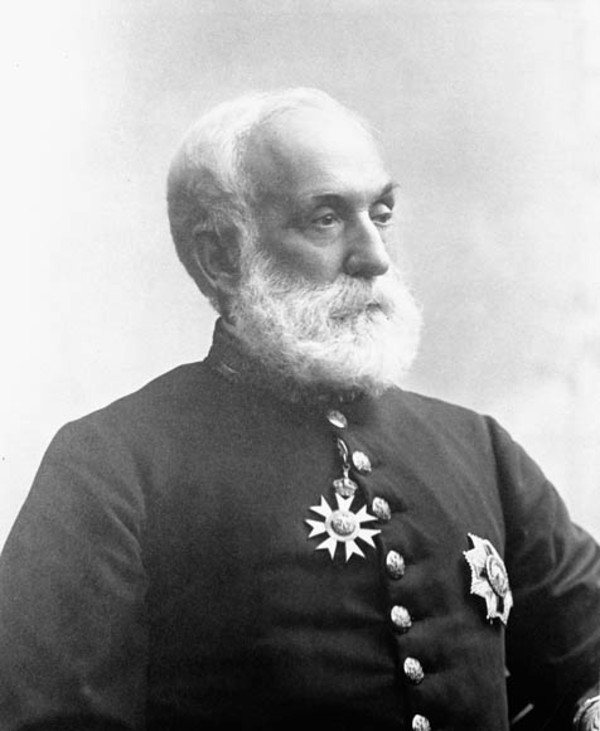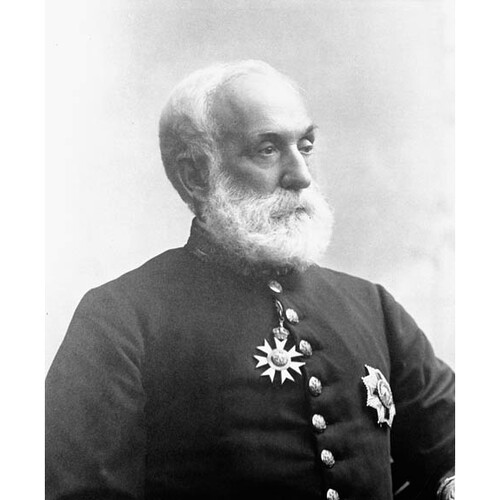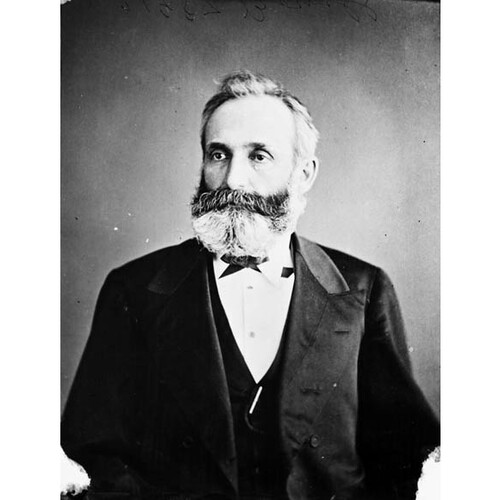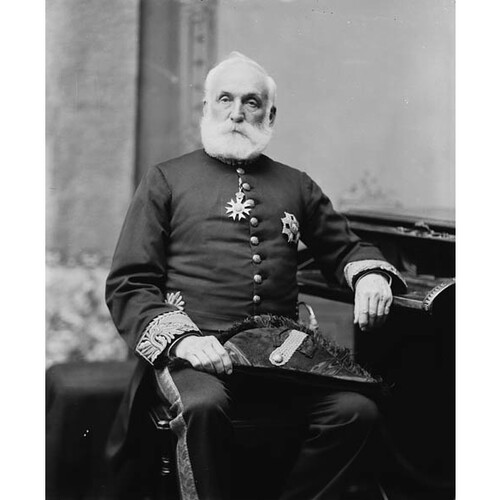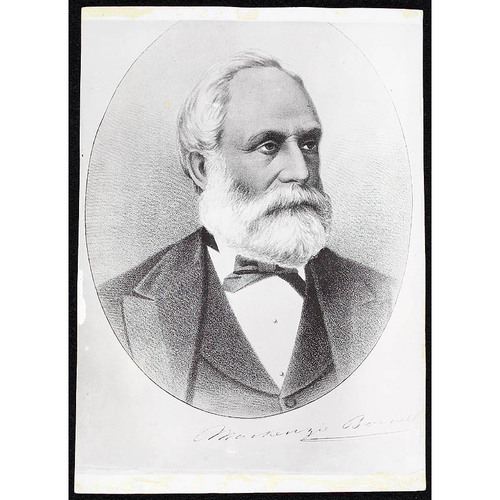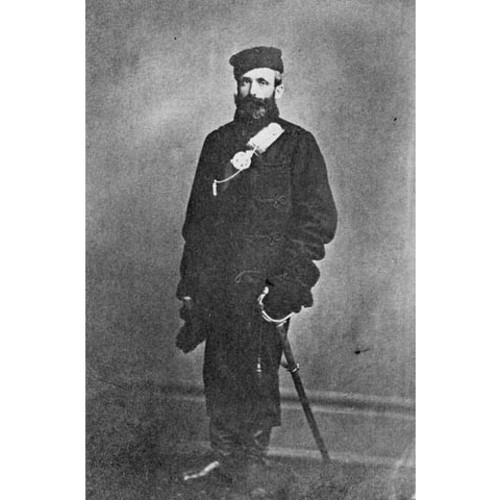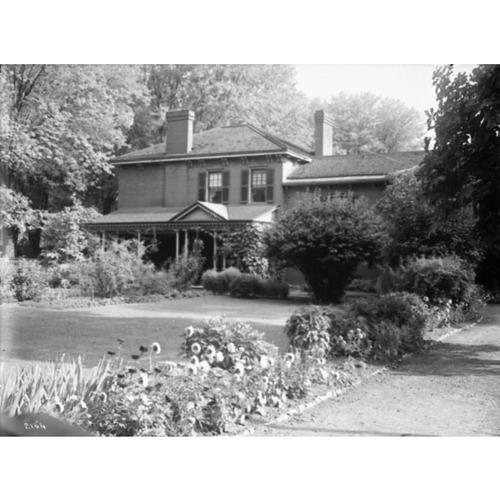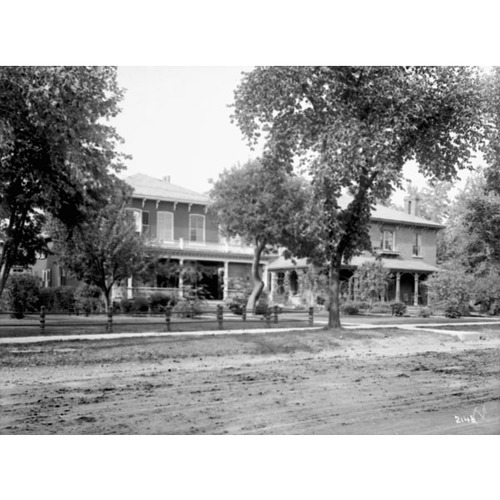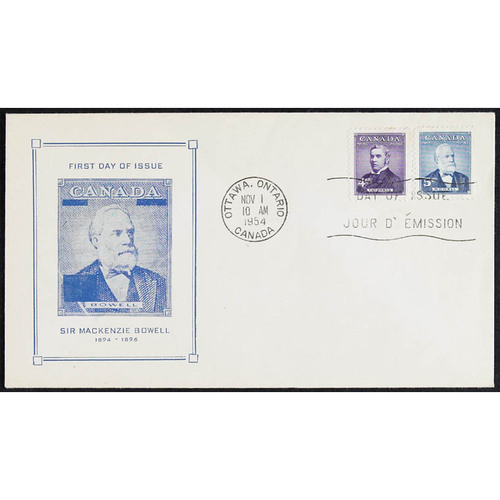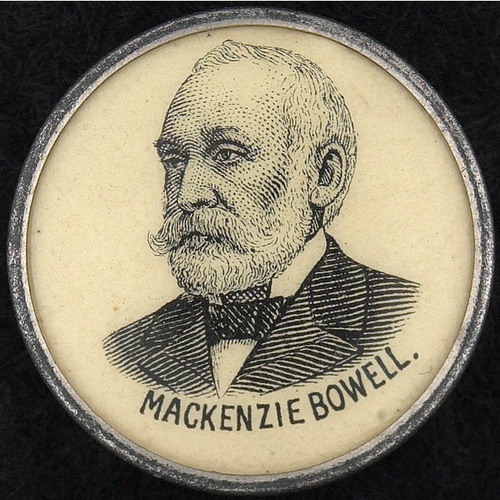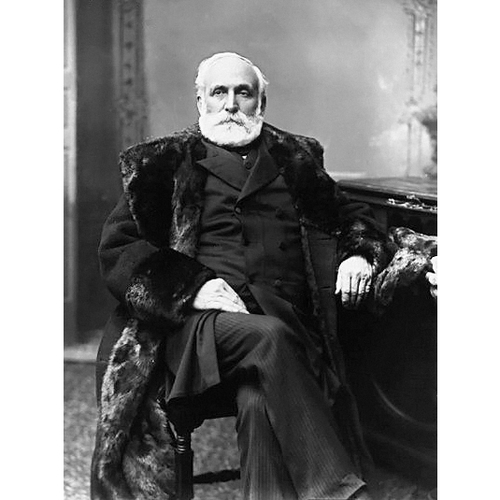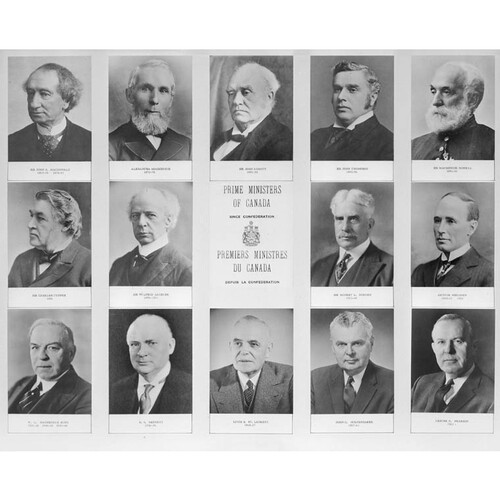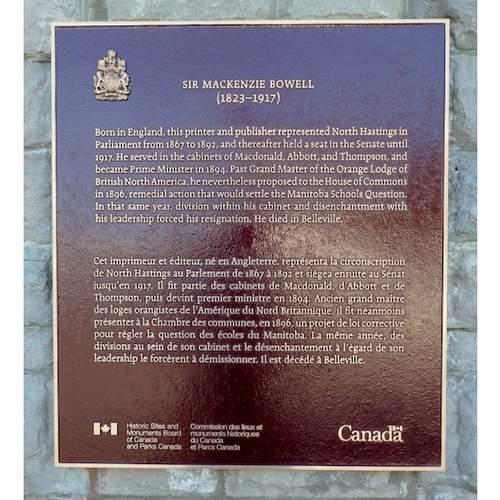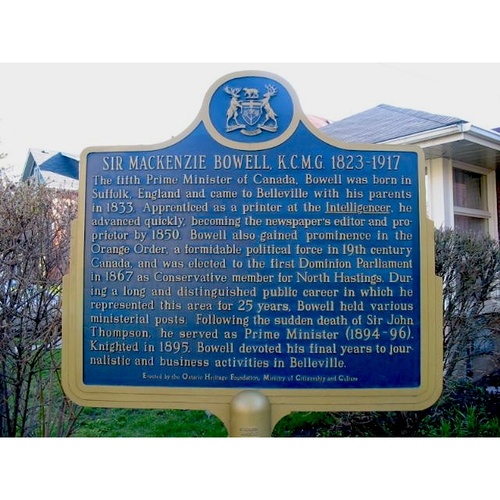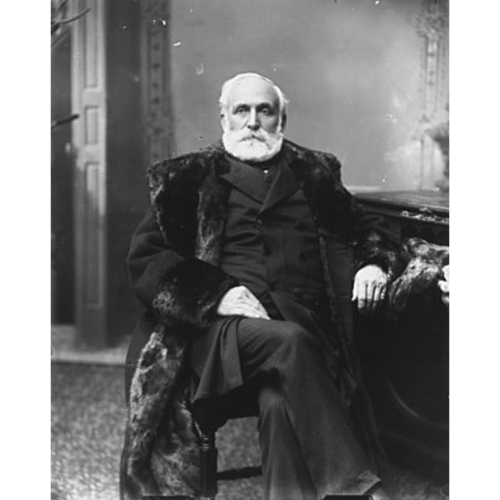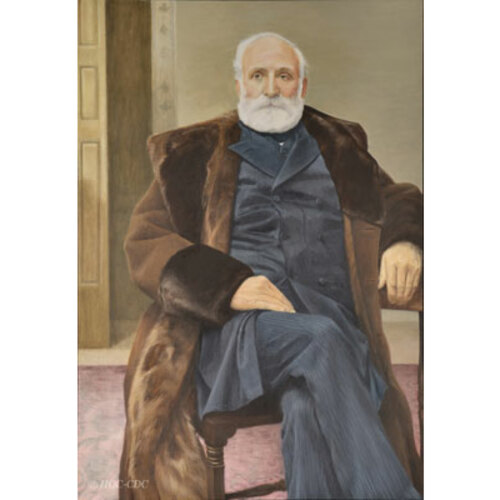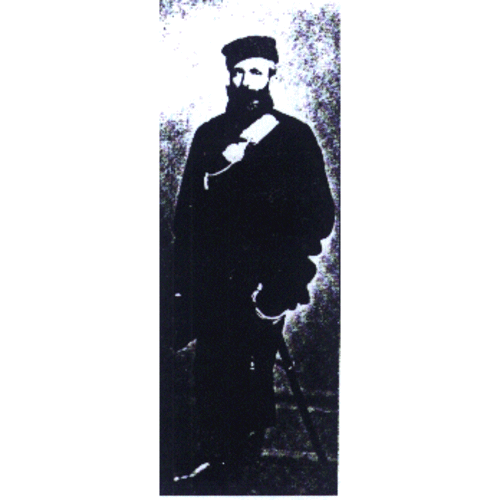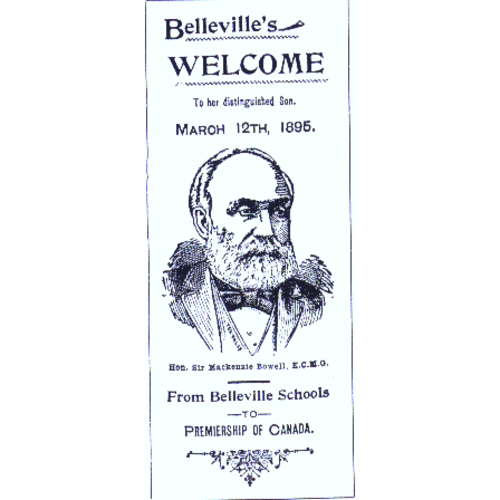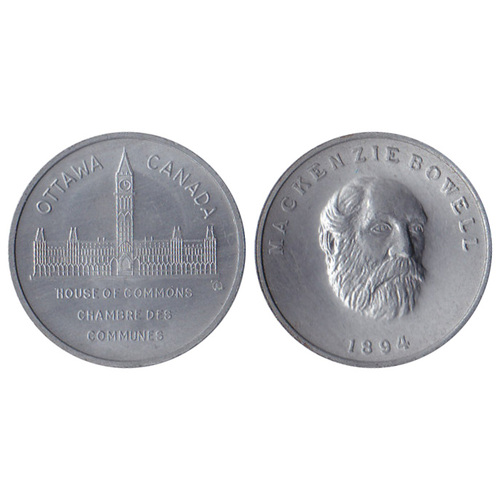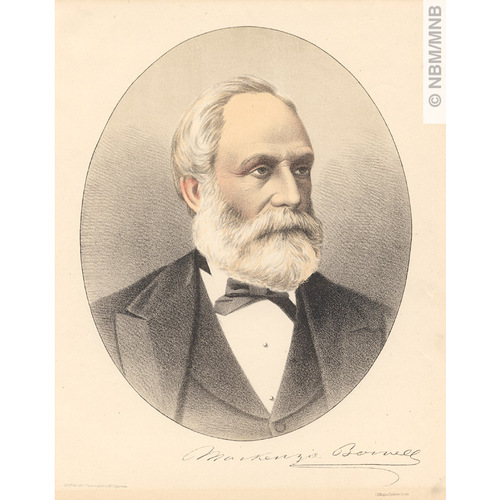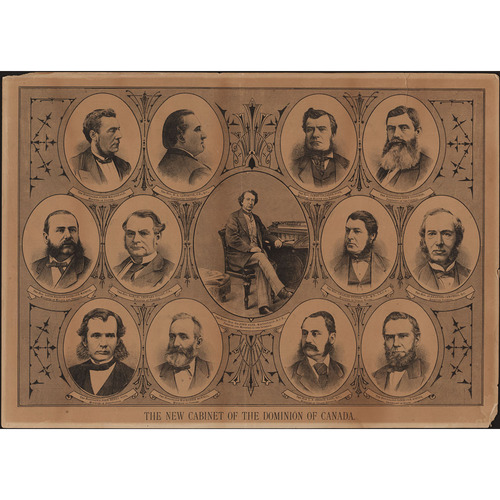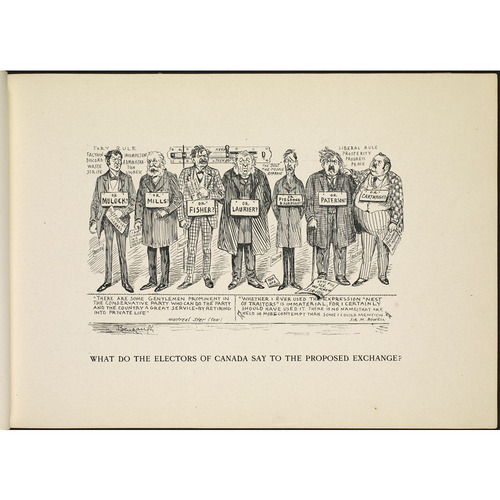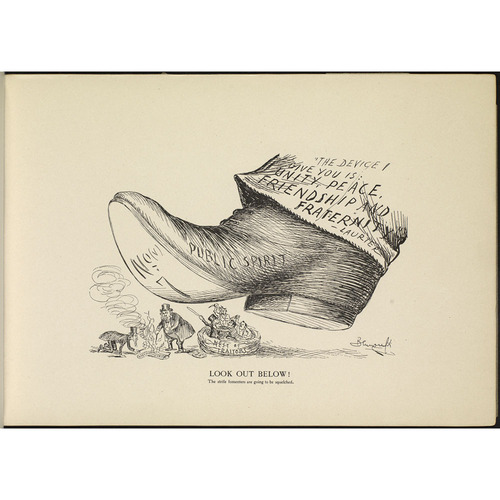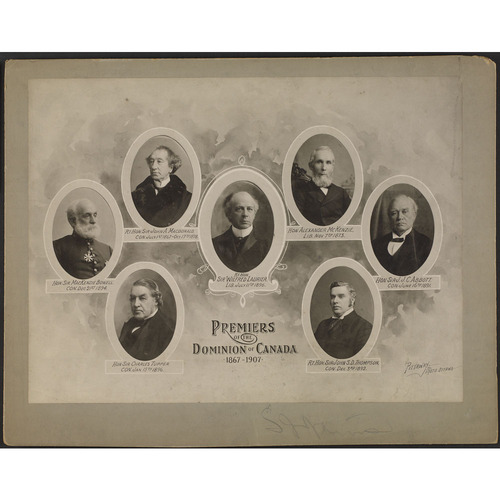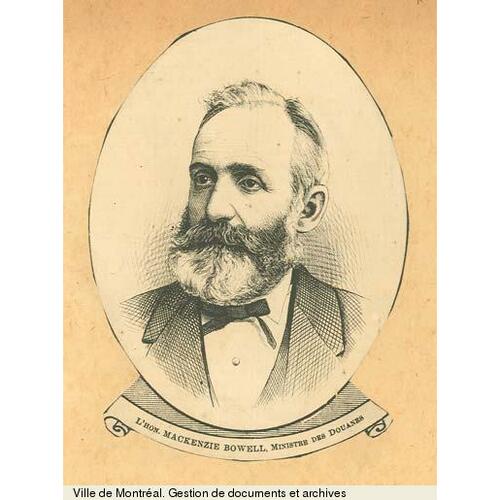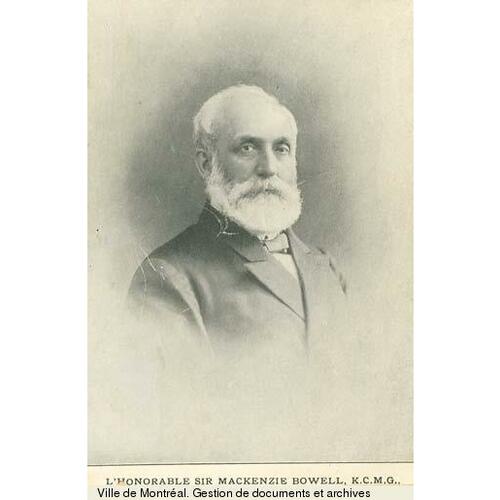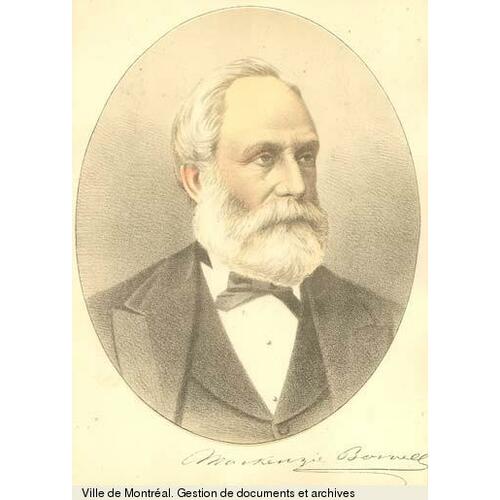As part of the funding agreement between the Dictionary of Canadian Biography and the Canadian Museum of History, we invite readers to take part in a short survey.
BOWELL, Sir MACKENZIE, newspaperman, militia officer, Orangeman, and politician; b. 27 Dec. 1823 in Rickinghall, England, son of John Bowell and Elizabeth Marshall; m. 23 Dec. 1847 Harriet Louisa Moore (d. 1884) in Belleville, Upper Canada, and they had four sons and five daughters; d. there 10 Dec. 1917.
Mackenzie Bowell emigrated to the Canadas with his parents in 1833. It took them eight weeks to reach Quebec City and another week to go from Montreal to the Bay of Quinte, on the north shore of Lake Ontario. They settled there in the village of Belleville, where John Bowell had relatives. He was a cabinet-maker and Mackenzie learned that trade. Though he continued to help his father in the evenings, in 1834 or 1835 he went to work as a printer’s devil for George Benjamin*, editor and owner of the Belleville Intelligencer.
Young Mac served as Benjamin’s right hand, especially when Benjamin was in politics. In 1848 he became a partner in the Intelligencer; the following year he and his brother-in-law took over its printing business. Bowell assumed sole proprietorship of the weekly in the early 1850s. In 1867 he launched a daily edition and in 1875 the Intelligencer Printing and Publishing Company was incorporated. A founding member of the Canadian Press Association in 1859, he was its president in 1865–66.
Bowell’s rise came as much from steady public involvement as it did from journalism. The chair for several years of both the board of school trustees and the grammar school board, he was a member and vice-president of the local board of agriculture and arts as well. In 1865, with Henry Corby*, Billa Flint*, and others, he established a board of trade; Bowell himself was a president or director of several companies besides the Intelligencer. A keen supporter of the militia in Hastings County, he helped organize the Belleville Volunteer Militia Rifle Company in 1857; he saw active duty at Amherstburg, Upper Canada, during the American Civil War, and at Prescott during the Fenian disturbances of 1866. He would retire from the militia in 1874 with the rank of lieutenant-colonel in the 49th (Hastings) Battalion of Rifles. During these decades Bowell gained recognition too as a leading member of the Orange order, which he had joined in 1842. In 1870–78 he was grand master of the lodge in British North America, and in 1876, in Londonderry (Northern Ireland), he was elected president of the order’s Imperial Triennial Council.
When George Benjamin chose not to run for re-election in Hastings North in the provincial election of 1863, Bowell decided to try his hand there as the Conservative candidate. Helping him campaign was Benjamin’s last major effort – he would die the following year. Bowell was defeated but he was elected for the same constituency to the new House of Commons in 1867. He would hold Hastings North for the next 25 years.
Bowell first came into political prominence in April 1874, when, as an Orange spokesman, he moved for the expulsion from the commons of Louis Riel*, leader of the uprising at Red River (Man.). A casualty of that event had been Thomas Scott*, an Irish Orangeman from Hastings whose execution stirred passions there. In 1878, after the Conservatives’ electoral victory, Sir John A. Macdonald* appointed Bowell minister of customs, a portfolio he would retain until after the prime minister’s death. His principal task was the supervision of the main source of government revenue. As a consequence of the National Policy tariff of 1879 many new rules were established and a number of new rates based on the ad valorem principle were adopted. A board of dominion customs appraisers was created in June 1879, including appraisers from Halifax, Saint John, Quebec, Montreal, Kingston, Toronto, and London. Bowell believed it was essential to have common policies; it was already apparent that different ports gave different evaluations for the same goods. Moreover, an ad valorem determination of duties meant that invoices could be, and often were, deliberately understated. The Customs Act clearly laid down that the invoiced value had to be based on fair market price in the country of origin. The board of appraisers reported to Bowell that its actions provoked grumblings and some enmity from importers, but customs was like that. As the board’s secretary, Charles Belford*, noted, “The ‘ignorant impatience of taxation’ is not confined to the thoughtless or the uneducated.”
In the political side of his office, Bowell dealt mainly in the small change of politics: jobs, salary increases, promotions, and patronage. He seems to have been scrupulous in following government rules, but there were exceptions. Macdonald frequently enquired of him, in benign fashion, when, where, and if the rules might be bent. A minor customs appointment was suggested in a covering letter from Macdonald in 1884: “If you can possibly do this for the Bishop do it. It is of very great importance just now to keep him not only friendly but Earnest in the cause.” Even more headstrong members of cabinet learned to write in the same vein. Sir William Young*, former chief justice of Nova Scotia, asked railways minister Sir Charles Tupper if two iron summer-houses being made in Glasgow for Point Pleasant Park in Halifax could be brought in free of duty. Tupper sent the letter to Bowell, asking “What can you do for Sir William?”
Bowell would not always bend before political requests. Paul-Étienne Grandbois, mp for Témiscouata, Que., came to Macdonald in July 1884 with a plea for a constituent, a Captain Charette, whose vessel had been seized for smuggling spirits from Saint-Pierre and Miquelon. It was a clear case. The cargo was condemned, but Grandbois pleaded for the restitution of the vessel to Charette on the ground that he was a simple-minded man of good character. Macdonald sent affidavits to Bowell “so that you may if possible have mercy upon the owner of the schooner and let him off as easily as your conscience will allow.” Bowell in return sent Macdonald a full documentation of the seizure. After reading this dossier Macdonald backed Bowell completely, agreeing that “the most rigorous steps should be taken to condemn the vessels [apparently more than one was involved] and to bring all the parties to justice.”
Bowell’s talents were administrative: he was conscientious, hard-working, and scrupulous. Customs, with its large bureaucracy, steadily changing schedules of rates, stream of demands from manufacturers and importers, and detailed fiscal components, required such talents. Moreover, Bowell was patient at unravelling patronage problems. The postmastership of Belleville in 1880 is a case in point. Senator Robert Read of Belleville wanted it for his son-in-law, both men from large families of Conservatives. The brother of Sir Alexander Campbell*, the postmaster general, was also a candidate. Belleville distiller Henry Corby wanted it for a nominee of his and wrote Macdonald accordingly. It was this letter, passed on to Bowell by Macdonald, that occasioned Bowell’s revelation of the actual situation in Belleville. He calmly gave his chief a tour d’horizon of the postmastership and then added, almost as an afterthought, that “the position is not vacant nor do I know when it will be as the present Post Master Mr. [James Hubbard] Meacham is to all appearances as capable of performing the duties as he has been for years past and has no intention of resigning, and cannot under the law be superannuated not being a Civil Servant but paid by fees.”
After Macdonald’s death in 1891 Bowell retained his customs portfolio under John Joseph Caldwell Abbott*. In addition, he was acting minister of railways and canals from June 1891 to January 1892, at which time he was made minister of militia and defence. On the accession of Sir John Sparrow David Thompson* as prime minister in December 1892, Bowell was elevated to the Senate and became government leader there, with a newly created portfolio, trade and commerce. He was assigned two controllers as assistants: John Fisher Wood* for inland revenue and Nathaniel Clarke Wallace* for customs.
When Thompson went to Paris in March 1893 as a British representative on the arbitration over sealing in the Bering Sea, Bowell, as senior minister, became acting prime minister. His selection had nothing to do with his talents; it was simply the custom that the senior minister assumed this duty. It may be a measure of Thompson’s lack of full confidence in Bowell that much of the significant correspondence, while Thompson was in Paris, is with George Eulas Foster*, acting leader in the commons.
In September 1893 Bowell, as minister of trade and commerce and duly instructed by cabinet, went to Australia with Sandford Fleming to talk about trade between the Australasian colonies and Canada and the proposed Pacific cable. He went by the new Vancouver-Sydney steamship line, itself a point of discussion, and returned in January 1894. The results of his work were so encouraging that Canada took the initiative in calling an intercolonial conference, to meet in Ottawa at the end of June to discuss intercolonial trade and imperial preference. The conference was really Bowell’s idea. Six of the seven Australian colonies sent delegates, as did Fiji, the Cape Colony, and a still independent Hawaii. The British government sent an observer, not a delegate; it was not at all sure it liked such colonial initiatives.
The conference of 1894 may well represent the best reach of Bowell’s talents. He was 71, an age when many think of honours, reputation, and coasting. The Australian adventure had been a great fillip to his self-esteem. Younger cabinet colleagues called him Grandpa Bowell; he looked the part, with his full white beard, but the appellation may also have signified intellectual limitations. There is evidence that Thompson was looking for ways to ease him out of cabinet when Thompson died suddenly on 12 Dec. 1894 in England.
Governor General Lord Aberdeen [Hamilton-Gordon*] now had a difficult choice. The cabinet had been held together, disciplined one might say, by Thompson’s strength, suavity, and knowledge. It now fell back into constituent parts, each with members who displayed individual prejudices and jealousies. Thompson had left no intimations about a successor, and there was no clear choice. Foster was able but waspish. John Graham Haggart was able but lazy, and, as Lady Aberdeen [Marjoribanks*] said, “a Bohemian.” Neither would serve under the other. Sir Charles Hibbert Tupper*, probably the most capable and resolute member of cabinet, was self-willed and headstrong. None of the others offered much. The one person in the Conservative party left out of the consideration was old Sir Charles Tupper, then in London as Canada’s high commissioner. Thompson had grown to dislike Tupper Sr, his pushy ways, his penchant for the improvement of Tupperdom. Thompson’s view was shared by his widow, Annie Emma [Affleck], and, even more important, by Lady Aberdeen. Any prejudice that Lord Aberdeen had acquired against the elder Tupper via Sir John Thompson had ample domestic reinforcement.
When Thompson had gone to London in 1894, Bowell was again acting prime minister. On 13 December, the day after Thompson died, Lord Aberdeen invited Bowell to discuss the position of affairs with his cabinet colleagues, and with him. Bowell said he would not consult his colleagues. He doubtless knew what their opinions were on his becoming prime minister, but he would see the governor general, leaving Lord Aberdeen free afterward to consult whomsoever he chose.
After conferring with a prominent Roman Catholic senator, Sir Frank Smith*, about Bowell’s political suitability, the governor general asked him on the evening of the 13th to form a government. By the 21st Bowell had put a government together, with himself as president of the Privy Council as well as prime minister. The new administration included all the ministers from Thompson’s cabinet save Sir John Carling; eight members kept their previous positions. Bowell was delighted with his accession to the highest political office in the country. Knighthood came to him on New Year’s Day 1895. He had never been guilty of underestimating his own capacity. Now his vanity expanded beyond reason. He had seen a good deal of Sir John A. Macdonald’s methods of governing the party and he believed he could emulate him. But to imitate Macdonald demanded a reach of intelligence and a finely tuned discrimination wholly unavailable to Sir Mackenzie Bowell. What to him was cleverness was, to others, evasion, weakness, unreliability, and fatuity. The governor general found that Bowell liked to have a trapdoor for escape in case of danger. Moreover, it was difficult to hold him to a point of policy because he had not sufficiently possessed himself of it in the first place or, if he had, he had forgotten. Aberdeen thus had reason to become uneasy about so slippery a prime minister, one who found it difficult to be frank and could not be trusted.
In Bowell’s defence, it has to be said that his ministry was split into factions and that the Canadian ship of state had in these months a very hard helm. One difficulty was Manitoba. There the Roman Catholic minority clamoured for federal remedial legislation to restore the public support to their schools that had been abolished by the provincial government of Thomas Greenway*. The decision of the Judicial Committee of the Privy Council in the Brophy case, delivered on 29 Jan. 1895, forced the federal government to redress their grievances. Bowell’s Orangeism did not block his willingness to do whatever the law said he must do for the aggrieved Catholics. But what action was to be taken? How was it to be implemented? Should there be, as some wanted, a general election first? To these questions the members of the Bowell cabinet returned different answers. If ever a government needed a firm, judicious hand, it was now.
One member, minister of justice C. H. Tupper, succeeded in persuading his colleagues to accept the principle of the remedial order. It was issued on 21 March as an order in council, which declared that Manitoba must pass new legislation restoring to Roman Catholics their separate school privileges. At first the government went along with Tupper, that, having issued the remedial order, it would go to a dissolution at once. But several English-speaking members of cabinet then urged upon Bowell the ingenious idea of a further session, in 1896, which would delay the whole nasty issue and perhaps even allow time for it to be solved without a plunge into an election. Tupper did not like this course; indignant over the repudiation of a clear-cut policy, he tendered his resignation on the 21st. Bowell replied that to appeal to the country when the heather was afire would be inexcusable. Tupper retorted angrily on the 25th that “the beginning of the blaze is a more auspicious period than the middle. . . . You cannot, I fear, keep Parliament together long enough to see the end of this fire.” The intervention of the governor general, Senator George Alexander Drummond*, and Sir Donald Alexander Smith, brought Tupper back at the end of March with the proviso that if no settlement with Manitoba was reached, remedial legislation would be introduced in the 1896 session.
Bowell seems to have believed that a political settlement with Manitoba was possible and that there was going to be no need to put a difficult and complex constitutional issue to the arbitrament of the hustings. Manitoba’s clever reply in June 1895 to the remedial order held out hopes that, with more information and negotiation, some compromise could be reached. By January 1896, however, things had turned for the worse. Senator Auguste-Réal Angers, the minister of agriculture, had resigned in July 1895 and Bowell could not find a French Canadian to replace him; the government had lost two critical by-elections in Quebec over the school issue; and Nathaniel Clarke Wallace, Orange grand master and the great anti-remedialist in the ministry, had resigned in December. Parliament opened on 2 Jan. 1896 with the government in furious disarray. Within 24 hours there was a revolt against Bowell by about half the cabinet; seven ministers resigned on the 4th and urged the governor general to replace Bowell with old Sir Charles Tupper. The seven were led by Foster, Haggart, and Walter Humphries Montague [see John Fisher Wood]. Thomas Mayne Daly, a loyal cabinet colleague, encouraged Bowell to be reasonable for the sake of the party. The session would be a rough one and strong men would be needed on the government side. However much Bowell disliked the seven “traitors,” he needed them. He would not be able to get others, not on the eve of a divisive session over which hung a sinister cloud: the general election that had to be called by 25 April 1896. Furthermore, Daly pointed out, if Bowell did not have a government the governor general would soon have to find another one.
Aberdeen’s actions in helping to patch up this cabinet rupture were based on his dislike of calling in Tupper as prime minister. As important was his mistaken belief that the seven rebels had, as the basis of their insurrection, the aim of avoiding remedial legislation, to which the cabinet was pledged. Here the governor general was almost certainly misled by Bowell, whose vanity could not allow that the rebels disliked him personally. Bowell therefore alleged the policy difference. Hence, Aberdeen pressed him to try to reconstruct. But after four days, 4–7 January, Bowell had to give up. Early on the 8th he formally tendered his resignation.
Then an odd event occurred. That afternoon, in room 25 of the Senate, Angers, Joseph Bolduc, and Philippe Landry were talking with three mps when the governor general’s aide-de-camp knocked on the door, asking to speak to Angers. Aberdeen wanted private advice from him on what to do about Bowell’s resignation. Angers’s advice was given at once: refuse the resignation on the grounds that the house had not yet voted its reply to the speech from the throne. This position is precisely the ground Aberdeen took later that day in refusing Bowell’s resignation.
Several rebels then learned that Aberdeen had not been given the true state of affairs by Bowell. They went to Government House with their version, that they and certainly old Sir Charles Tupper were not anti-remedialists. This account was news to Aberdeen. Next the newspapers reported that Aberdeen’s aide had been seen visiting Wilfrid Laurier, leader of the opposition. The rebels jumped to the conclusion that Aberdeen was thinking of calling on him to form a government. That did it. As C. H. Tupper said, “We all turned in like sheep into the fold, at the very rumour.” The “traitors” returned to cabinet on 15 January with the exception of C. H. Tupper, who was left out in the reshuffle of ministers because of his father’s likely return. Thus did the rebels come back, with the compromise that Tupper Sr would lead in the commons and that, when the session was over, Bowell would resign as prime minister and Tupper would take over the government and go to an election.
That was what happened. Still, there were hopes, never abandoned by the governor general or the government, that Manitoba might agree to a compromise before any election, that remedial legislation, though introduced in parliament on 11 February, might still not have to be passed. Even after the motion for second reading came up three weeks later, hopes and negotiations were not abandoned. But the determined opposition of the Liberal party to the remedial bill, which was withdrawn on 16 April, and the simple fact that the government had to dissolve before 26 April, made the running. Bowell’s resignation on the 27th, as promised, was not much regretted. So well did Tupper fight the election of June 1896 that he actually got more popular votes than Laurier (46 per cent against 45), but Laurier won on the basis of seats in Quebec, which went 49 to 16 for the Liberals.
Bowell returned to the Senate, never forgetting or forgiving the “traitors” of January 1896. He was anything but a fainéant. Instead of retiring in decent obscurity to Belleville, he stood loyally to his work in the Senate. For the next two decades its Debates are full of his interventions. In 1896 too he resumed active control of the Intelligencer, which he had relinquished in 1878. At his 90th birthday in 1913 he was still going to his office at the newspaper, still inordinately vain, proud, for example, at people not guessing his age. He looked only 65, almost the age of his eldest daughter. In 1916, at 93, he set out to visit his son in Vancouver and then go on to the Yukon. The following year he died quietly at his William Street home in Belleville of old age and pneumonia, and was buried in Belleville Cemetery, just west of the city.
Sir Mackenzie Bowell began his career with lusty Orange prejudices, but by the 1880s his fighting spirit was subsumed within Conservative politics and his Orange positions had softened. According to the Toronto Globe, it was Bowell who succeeded in making the Orange order more friendly to Catholics. That tolerance was born of political necessity. At Bowell’s death, the Belleville Daily Ontario noted that he was not a great lawmaker or parliamentarian; he had no independent cast of mind. But mere mediocrity could not have taken him as far as he went. His aptness for public life was “administrative rather than constructive . . . he administered the affairs of that department [customs] honestly, fearlessly, efficiently. He left to others the long speeches and the framing of the statutes, while he kept the machinery of the government in motion.” That is about as good an epitaph as Bowell, vain as he was, could have asked for. Others, Lord Aberdeen not least, set him down more harshly. Unreliable as Bowell was, his honesty seemed to them to be not the triumph of a strong mind, but the refuge of a weak one.
[Though he was long in politics, Sir Mackenzie Bowell’s papers at the NA (MG 26, E) are not extensive, and they are particularly thin – virtually non-existent – for the years before 1867. His correspondence with Sir John A. Macdonald is in volumes 189–90 of the Macdonald papers (MG 26, A), and there are a number of Bowell letters, filed in chronological order, in the Thompson papers (MG 26, D). A small but useful collection of Bowell papers, mostly covering the period 1865–78, is available in QUA, and two Bowell scrapbooks, consisting of numerous clippings and cartoons (often, unfortunately, without provenance), are in the collections of the Hastings County Hist. Soc. at the Belleville Public Library, Belleville, Ont. (a microfilm copy is available at QUA). For Bowell’s year and a half as prime minister, there is no better source than [I. M. Marjoribanks Hamilton-Gordon, Marchioness of] Aberdeen [and Temair], The Canadian journal of Lady Aberdeen, 1893–1898 (Toronto, 1960), especially John T. Saywell’s elegant introduction to it. p.b.w.]
AO, RG 22-340, no.5320. Ottawa Evening Journal, 11 Dec. 1917. Sentinel and Orange and Protestant Advocate (Toronto), 27 July 1899. G. E. Boyce, Historic Hastings (Belleville, 1967). Canada, an encyclopædia (Hopkins), 6: 223–26, 268. Canadian annual rev. (Hopkins), 1901–8. Canadian biog. dict. Canadian men and women of the time (Morgan; 1912). CPG, 1874, 1905. Encyclopaedia of Canadian biography . . . (3v., Montreal and Toronto, 1904–7), 1. O. M. Hill, Canada’s salesman to the world: the Department of Trade and Commerce, 1892–1939 (Montreal and London, 1977). A history of Canadian journalism . . . (2v., Toronto, 1908–59; vol.1 repr. New York, 1976). Ontario Register (Lambertville, N.J.), 8 (1990): 216. P. B. Waite, Canada, 1874–1896: arduous destiny (Toronto and Montreal, 1971).
Cite This Article
P. B. Waite, “BOWELL, Sir MACKENZIE,” in Dictionary of Canadian Biography, vol. 14, University of Toronto/Université Laval, 2003–, accessed March 29, 2025, https://www.biographi.ca/en/bio/bowell_mackenzie_14E.html.
The citation above shows the format for footnotes and endnotes according to the Chicago manual of style (16th edition). Information to be used in other citation formats:
| Permalink: | https://www.biographi.ca/en/bio/bowell_mackenzie_14E.html |
| Author of Article: | P. B. Waite |
| Title of Article: | BOWELL, Sir MACKENZIE |
| Publication Name: | Dictionary of Canadian Biography, vol. 14 |
| Publisher: | University of Toronto/Université Laval |
| Year of revision: | 1998 |
| Access Date: | March 29, 2025 |


